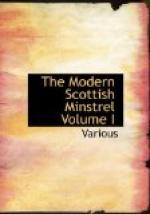As a man of amiable dispositions and incorruptible integrity, Sir Walter Scott shone conspicuous among his contemporaries, the latter quality being eminently exhibited in his resolution to pay the whole of his heavy pecuniary liabilities. To this effort he fell a martyr; yet it was a source of consolation to his survivors, that, by his own extraordinary exertions, the policy of life insurance payable at his death, and the sum of L30,000 paid by Mr Cadell for the copyright of his works, the whole amount of the debt was discharged. It is, however painfully, to be remarked, that the object of his earlier ambition, in raising a family, has not been realised. His children, consisting of two sons and two daughters, though not constitutionally delicate, have all departed from the scene, and the only representative of his house is the surviving child of his eldest daughter, who was married to Mr John Gibson Lockhart, the late editor of the Quarterly Review, and his literary executor. This sole descendant, a grand-daughter, is the wife of Mr Hope, Q.C., who has lately added to his patronymic the name of Scott, and made Abbotsford his summer residence. The memory of the illustrious Minstrel has received every honour from his countrymen; monuments have been raised to him in the principal towns—that in the capital, a rich Gothic cross, being one of the noblest decorations of his native city. Abbotsford has become the resort of the tourist and of the traveller from every land, who contemplate with interest and devotion a scene hallowed by the loftiest genius.
“The grass is trodden
by the feet
Of thousands,
from a thousand lands—
The prince, the peasant, tottering
age,
And rosy schoolboy
bands;
All crowd to fairy Abbotsford,
And lingering
gaze, and gaze the more;
Hang o’er the chair
in which he sat,
The latest dress
he wore."[73]
[72] We regret that, owing to the provision of the copyright act, we are unable, in this work, to present four of Sir Walter Scott’s most popular songs, “The Blue Bonnets over the Border,” “Jock o’ Hazeldean,” “M’Gregor’s Gathering,” and “Carle, now the King’s come.” These songs must, however, be abundantly familiar to the majority of readers.
[73] From “The Grave of Sir Walter Scott,” a poem by Thomas C. Latto (see “The Minister’s Kail-yard, and other Poems.” Edinburgh, 1845, 12mo). To explain an allusion in the last line of the above stanza, it should be noticed, that the last dress of the poet is exhibited to visitors at Abbotsford, carefully preserved in a glass case.
IT WAS AN ENGLISH LADYE BRIGHT.[74]
It was an English ladye bright
(The sun shines
fair on Carlisle wall),
And she would marry a Scottish
knight,
For Love will
still be lord of all.
Blithely they saw the rising
sun,
When he shone
fair on Carlisle wall;
But they were sad ere day
was done,
Though Love was
still the lord of all.




